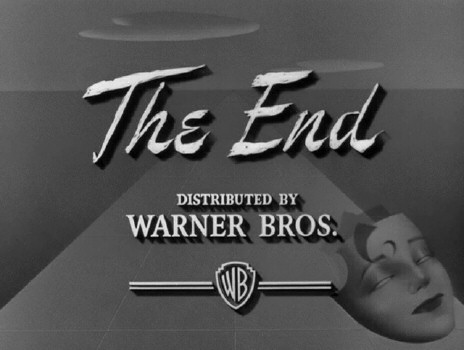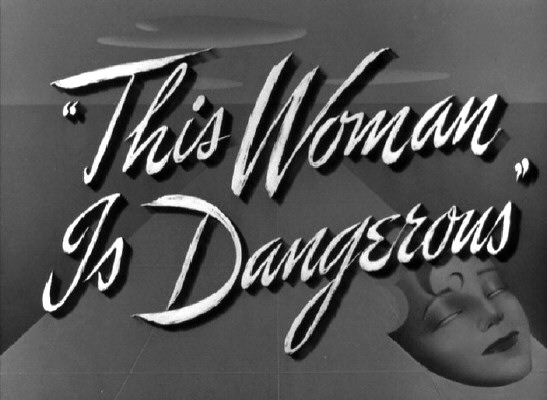
The Best of Everything
Encyclopedia Entry • Films Main
This Woman is Dangerous
1952

Critics' Reviews • Our Reviews • Movie Posters • Lobby Cards • Misc. Images
Click here to see photos from the film.
|
US general release: 2/9/52.
Warner Archive DVD release: 3/23/09. Cast: Joan Crawford (as "Beth Austin"), Dennis Morgan, David Brian, Richard Webb, Mari Aldon, Philip Carey, Ian MacDonald, Katherine Warren, George Chandler, William Challee, Sherry Jackson, Stuart Randall, Douglas Fowley. Credits: Original story, "Stab of Pain," by Bernard Girard. Screenplay: Geoffrey Homes, George Worthing Yates. Producer: Robert Sisk. Director: Felix Feist. Camera: Ted McCord. Art Director: Leo K. Kuter. Music: David Buttolph. Wardrobe: Sheila O'Brien. Editor: James C. Moore.
Plot Summary: Joan Crawford is appropriately cast as the title character in This Woman is Dangerous. Crawford plays master criminal Beth Austin, the lady friend of dangerous gangster Matt Jackson (David Brian). After being caught in the crossfire of a robbery engineered by Jackson, Beth recuperates in a hospital, hoping to keep her past a secret from the authorities. But the FBI wants Beth to lead them to Jackson, and to that end, her doctor Ben Halleck (Dennis Morgan) is strong-armed into inaugurating a romance with his gorgeous patient. Eventually, of course, Ben and Beth fall genuinely in love, thereby incurring the terrible wrath of the vengeful Jackson. And to think that Joan Crawford endures all this without a hair out of place on her lovely head! TV's future "Captain Midnight" Richard Webb co-stars as a diligent FBI agent. ~ Hal Erickson, All Movie Guide
Notes: Filmed on location in Pasadena and at the Los Angeles County Hospital. Joan's last film under contract to Warners.
|
Bosley Crowther in the New York Times February 28, 1952
When trouble comes to Joan Crawford in her motion-picture roles, it doesn't come in small doses; it comes in great big agonizing hunks. Consider "This Woman Is Dangerous," which came to the Paramount yesterday. In this Warner Brothers' "draymer," the incredibly durable star, whose theatrical personality has now reached the ossified stage, appears as a woman criminal who has two pressing problems on her hands; one is a vilely jealous boyfriend and the other is the fact that she is going blind. A third and lesser annoyance—in the script writers' eyes, at least—is a niggling and childish matter of the law's discourtesy. Somehow, those mean old detectives keep tapping her wire and such. However, the faltering hand of justice does not entirely descend upon this miserably tortured lady until she has undergone a critical eye operation, fallen beautifully and helplessly in love with her world-famous (also widowed) surgeon and balked her boy-friend's attempt to murder him. Then the cold hand of justice gives evidence of an exceedingly sympathetic touch. We are led to suppose that the lady and the famous surgeon will be sublimely wed just as soon as she has been down to the courthouse and explained those few robberies and things to the judge. There is only one possible explanation, however, for such fictitious junk as this, which is willfully delivered in the name of dramatic fare. That is as pure contrivance for the display of Miss Crawford's stony charm. Those who admire the actress may be most tenderly moved by the evidence of the suffering she stolidly undergoes—the studiously clinical operations, the painful efforts to resist her surgeon's love and the femininely torturing resolution to be loyal to her criminal pal. And to these, the arrant posturing of Miss Crawford may appear the quintessence of acting art. To these, too, the laughable performances of Dennis Morgan in the role of the internationally renowned eye surgeon and of David Brian as the jealous boy-friend may be equally convincing, since they are in the same pretentious style—all wrapped up and delivered under the direction of Felix Feist. But for people of mild discrimination and even moderate reasonableness, the suffering of Miss Crawford will be generously matched by their own in the face of "This Woman Is Dangerous." Remember! Big, agonizing hunks! On the stage at the Paramount are the Billy Williams Quartet, Georgia Gibbs, Buddy Lester, the Dunhills and Jerry Wald's orchestra.
Otis Guernsey in the New York Herald Tribune (1952): Joan Crawford runs through a series of problems concerning everything from the operating table to gangsterism in a long, windy, and tiresome story....A film of many pretenses but little conviction.
DVD Savant (2014)
|
If you've seen This Woman Is Dangerous and would like to share your review here, please e-mail me. Include a photo or avatar of yourself to accompany your review, as well as a star-rating (with 5 stars the best) and any of your favorite lines from the film.
|
Rating:
In 1973, Joan apparently said she considered TWID to be the very worst of her films (I can't find a source for this). And she's quoted in Conversations with Joan Crawford as saying: Nothing was right about This Woman Is Dangerous. A shoddy story, a cliche script, no direction to speak of. The thing just blundered along. I suppose I could have made it better, but it was one of those times when I was so disgusted with everything I just shrugged and went along with it.
All of that said, Joan also didn't think much of either Rain or Johnny Guitar! So she's perhaps not the most reliable critic of her own work. (Much less interesting films than TWID, in my opinion, just from the '40s and '50s: When Ladies Meet, They All Kissed the Bride, Above Suspicion, Goodbye My Fancy, Esther Costello.)
I found TWID to be a perfectly good minor noir/gangster picture. Joan's Beth Austin (not her real name, as we're later briefly told) is the mastermind of a rather rag-tag crime gang consisting of her boyfriend Matt (David Brian); his brother Will (Philip Carey); and Will's wife Ann (Mari Aldon), whom Beth apparently met in prison years ago and who introduced her to Matt. While the trailer for the film touts "From the rackets to the Ritz!" there's no indication that Beth's gang has been doing that well, given their usual post-job hideouts in RV parks and such. (Another deceptive trailer tag line: "Marked by the slanderous whispers of the whole town---until a GUN barked her strange story to the whole world!" Which seems culled more from the actual plot of 1950's The Damned Don't Cry rather than from this picture. Again, Beth and Co. seem to be living a rather seedy life, excepting the one big heist in New Orleans shown at the beginning of the film, at a casino, that allows Joan to wear furs and look momentarily "ritzy." There's certainly no indication that she's of interest to anyone other than her paranoid boyfriend or the FBI in their own private offices.)
Beth's minor criminal career is hindered by the fact that she has terrible headaches and blurry vision. In the very first scene of the film, a random doctor tells her that if she doesn't get an operation within ONE WEEK, she will certainly go blind, and so must go immediately to "The Halleck Clinic" in Indiana. Here's where the primary conflict starts: Criminal boyfriend Matt is a psycho hothead who's convinced, given past evidence, that Beth is not going away for an eye operation but is, rather, running around on him. His paranoia and drunken anger---and, ultimately, the violent crime he commits when he thinks Beth has left him---sets off a string of tails on Beth, both from a private eye hired by Matt and the FBI, which has found her fingerprints at the crime scene that she had no part of. All of this was still interesting to me: Outlaws vs the FBI, plus Real Love vs the Paranoia that comes with it! Which will destroy the main characters?
In the meantime, alas, Beth really is falling in love with the good Dr. Halleck (Dennis Morgan), who has saved her vision. While the hospital's nurses and phone operators steal her drinking glass for fingerprints and tap her phone conversations at the behest of the FBI, she's blithely going along on the Good Doctor's rounds and helping his annoyingly charming little daughter make dinner and do her homework, while wholesomely contemplating another possibility for her formerly wretched life... Says the formerly blind Beth sappily at the end of the home-evening: "Everything was distorted, blurry...But now I can see people and places as they really are."
I found all of the "Doctor stuff" to be a bit too saccharinely much. Morgan's Dr. Halleck, as written, is a picture-perfect "good guy" in every way (we're told that his ex-wife only left him because he worked too much, and, besides, she was "too impatient"---as if Criminal Mastermind Beth would not be!) And his little daughter, too, is too-perfect in her immediate embracing of Beth: "You belong here" say both father and daughter to Beth. But DOES she? The film, to its credit, provides a bit of ambiguity.
Within the rather insipid "getting to know the Doctor" sequence is a classic Joan scene. Dr. Halleck was initially supposed to take Beth out shopping but had to detour for a medical emergency at a local women's prison, leaving Beth sitting in the car. (He hasn't yet learned that Beth was ever in prison.) While Beth waits for him, she sees a group of prison women being lined up and inspected. The prison matron smells smoke and walks down the line of women. The camera cuts from the women in line, and the guilty woman pinching out her cigarette with bare fingers behind her back, to an antsy Beth in the car simultaneously pinching out her own cigarette with a gloved hand. Very good piece of film-making here! As is the next shot, once the prison women have gone inside, to Beth's car ashtray---once empty---now full of cigarette butts that she'd been smoking the whole time while waiting for Dr. Halleck to emerge.
Also interesting to watch are Beth's physical interactions with Psycho Matt. At the beginning of the film, when he's been previously berating her for fooling around (and she's only been at the first doctor's office), she calms him and he becomes solicitous, gently massaging her neck and temples. It's a sensual and warm scene that indicates that the two really do care for each other. I also thought that the last half-hour or so of the film was truly tense, noir-wise, as was the earlier scene when the policeman stopped the gangster brothers' RV on the highway after Matt had thrown a bottle through the window.
Brian's semi-psychotic "Matt" is the most interesting character in the picture. (I haven't read the original story that this film was based on, but I'm guessing that it might have been primarily Matt's story to begin with.) Joan is perfectly fine as "Beth Austin"---though she does, as in "Flamingo Road," play the semi-low-life role a bit too genteelly. (A truly subtle balance might have been "genteel" in public and with the Doctor, but slipping into "low-life" when around her gang---and occasionally with the Doctor, causing him to look askance.)
What might have made this a very good film: A slightly sleazy bad girl like Gloria Grahame as "Beth Austin"? Or: Something interesting about the Doctor---maybe he was a wonderful, kind person while Beth was blind, but a 5'4" overweight schlub once she actually saw him and so was torn about the pleasant life with a schlub or excitement with a bad boy? Or else a good-looking Morgan who was more-obviously dull and shallow and not at all to Beth's long-cultivated more-exotic taste in bad boys though he promises a different future?
At any rate: TWID, despite Joan's own latter-day protestations, is far from a bad film. It's not a great film, and it IS cliched in many places (mainly the Doctor places). But in other places, especially in the last half-hour, it's an intense Warners gangster-noir that's exciting to watch.
Rating:
This Woman Is Dangerous (TWID) is not the worst Joan Crawford film – Reunion in France is much more deserving of that label – and it is worth seeing. That being said, TWID is majorly derivative of previous Crawford films, especially Flamingo Road (FR) and The Damned Don’t Cry (DDC). David Brian is her co-star in all three. Unlike those earlier two films, however, Joan gives a lackluster performance in this one.
In TWID. Joan has graduated from an innocent ensnared in criminal activity (FR) to gun moll (DDC) to mastermind of a gang of armed robbers. Joan's "Beth Austin" supplies the "class” needed to pull off the heists. (She definitely has an A picture wardrobe, though the rest of the film appears to be B-minus level.)
Joan’s Big Problem that opens the film is that she is going blind and, after ignoring the symptoms, can now only be saved by an immediate operation by a Dr. Halleck in Indiana (Dennis Morgan, who gives a warm but dull performance). For reasons beyond me, Beth also has failed to confide her condition to her gang, which consists of her Psychopathic Boyfriend Matt Jackson (David Brian), and his brother and sister-in-law.
Beth pushes up the next heist to that same evening, and it goes off as planned. The following morning, her announcement that she has to go to the Indiana clinic that very day causes a reaction from Jackson, who then harbors suspicions that she's seeing someone on the side. (Beth makes no effort to do anything that might make him more comfortable, like set up regular communication.)
While Beth is at the hospital, a suspicious nurse helps several law enforcement agencies get her fingerprints while she is sedated. And while she's healing from the operation, Matt Jackson is also frantically trying to keep tabs on her. (Ian MacDonald plays Joe, the tail Jackson puts on her, and the conversation between Beth and Joe in the restaurant is the best scripted and acted scene in the movie.)
After Beth convinces Dr. Halleck to take her to Indianapolis, where she plans to take a flight back to Jackson, the doctor then detours to a women’s prison, where Beth, waiting for him in the car, has a psychological flashback involving a cigarette while she's watching the lined-up inmates being punished for smoking. (Of failed-continuity interest is the montage of the pair driving from the hospital to the prison that shows three different cars. And, speaking of driving, Joan drives more in this film than all her other movies combined, sometimes exhibiting the skills of a NASCAR driver when it comes to arriving somewhere unnaturally quickly.)
Of course, the doctor falls in love with the patient (Rule #3 in romantic dramas and #1 in Crawford movies) and is initially unsuccessful until he takes her to his house and introduces her to his neglected nine-year-old daughter, which softens Beth up a bit. After a homey scene between the daughter and Beth, the doctor sends the girl to bed and abandons her again to take Beth to the resort where she is staying. After Beth later gets to see the kindly doctor in action, performing miracle surgery on a local farm boy, she has a Crisis of Faith: Return to the farmhouse to help, or go back to her criminal gang and lifestyle?
Finally, the Dramatic Conclusion has arrived. I trust the intelligence of this audience, and my guess is that you can write the ending yourselves.
As
I say, this is not the worst Joan Crawford movie. It is a pleasant way
to pass an hour and a half. Joan bounced back later that year in Sudden Fear, a stylish triller where she has better makeup and softer lighting.
Rating:
Famously called by Joan Crawford herself to be her worst-ever film, This Woman Is Dangerous thus gets the dubious honour of being
called the star's least favourite motion picture in a film career that spanned 45 years and thus even worse than
Trog. But, is This Woman Is Dangerous really that bad?
Well, the answer for me, is no. In fact, it's quite an enjoyable watch. I am not talking Mildred Pierce or Humoresque levels of enjoyment here, but still a pleasant-enough way to pass 1:40 minutes. Dare I say it, I even prefer this film to Flamingo Road, a film that even Joan Crawford couldn't keep me glued to solidly for the duration of. This Woman Is Dangerous contains all the essential elements of many a Joan Crawford picture from the Warner Bros years. An at-times misunderstood heroine with a difficult past; a love triangle; lots of uses of guns and people being shot; and David Brian, an actor who was a male lead to several Crawford vehicles of the time. It's not the greatest film noir and you could say that it's a too-watered-down version of all the Crawford noirs that have gone before. But, somehow, the film works. All the lead cast work well within their respective roles, and there's a great chemistry between Miss Crawford and the other leading male star of the film, Dennis Morgan. And above all else, Joan herself is what really makes the film. During this time it was becoming apparent that, as they did with Bette Davis a few years previously, Warners was now over Joan and wanted her out. Knowing this, she accepted the script, took the part, and made the film before bowing out to start a career as a freelance artist. I am sure that it's due to the above why This Woman Is Dangerous gets a bad rep, especially compared to all the other pictures Joan Crawford made for her 7 years at the Warner Bros studio, plus notable loan-outs Daisy Kenyon and Harriet Craig. It really is NOT bad at all and by going into it with an open mind and knowledge that Miss Crawford will always act her socks off, I was left rather pleased. So, go on people, This Woman Is Dangerous really is not the great star's worst-ever film. At least not for this fan.
Rating:
This woman is dangerous? This woman is going blind? This woman runs a band of criminals? This woman is in love with her surgeon? This Woman is awful. This film is almost nonexistent to me even though it has a place in my DVD library.
Miss Crawford seemed to feel the same way or wished it was nonexistent. I never seem to be in the mood for this movie either. Trog at least gives you several options for entertainment value; this film has no options. It is, however, part of Hollywood history of what happened in those years and what fate and television and the studios did to our wonderful actresses. We even get to watch it happen. That would make a good film!
Goodbye. Thanks for the 18 years at MGM and thanks for the seven years at Warner Bros. Hollywood and the studio system are forever changed. Miss Crawford is now a freelance actress after this bomb! Her situation is great. It is wonderful and it is scary, just like this movie.
I mean, did it have to be blindness that she is afflicted with? Why not just get a check-up and she falls for the Doctor…ugh... what an awful script, and shame on Jack Warner for even attempting to put this film over. Which he did not! I cannot blame Miss Crawford entirely, but it is like selling old brownies at a bake sale -- not appetizing at all. But you do what you can and hope people won’t notice.
Many things or even a few small changes could have helped the script. In my opinion, there are three good scenes. The writers actually put something from every single one of Miss Crawford’s past films and several of Miss Bette Davis’s. Alas, with no feeling whatsoever.
Some casting changes might have benefited the overall look. Not a chance of that happening. I would have loved to have seen Thelma Ritter in there somewhere -- why not? There is nothing that can make the film and Miss Crawford credible and interesting. It is truly the theatre symbol of comedy and tragedy.
Miss Crawford was a professional, Miss Crawford was an actress, but most of all Miss Crawford was a survivor. Not many actresses survived after 1949, and I can list them all. The actresses that did made wholly unmemorable films boring and bad. Some had to go to television or the stage, and they did get a new lease on their careers. Some we would never see again. We would never see Hollywood again either. The fun in filmmaking was gone and that meant the love was gone.
Miss Crawford was faced with a deep, steep challenge. She was loyal and persevered, but things were changing very rapidly so that loyalty and talent did not matter…especially if you were a woman. True, she was also maintaining a glamorous lifestyle and raising a family and aging, so she took the job. She was still anti-television. (Jack Warner once called T.V. "the furniture that stares back”!) She was aware of the surmounting odds and some of the mistakes she made. Miss Crawford had to fight -- it was a basic instinct and reflex in her metabolism. She also was spiritual enough inside and took every opportunity to keep growing. Miss Crawford was a human being.
It takes a lot of guts to quit your job for something better and walk into the unknown. We have to thank the cinema gods for giving Miss Crawford Sudden Fear, filmed and released the same year as this wretched film.
Miss Crawford should actually be awarded for this film because she has done what not many actresses could do today! She did not quit but faced the challenges and expanded her career with co-producing her films. I applaud her. Unfortunately, the downward spiral was already happening. Miss Crawford managed to hold things up for a while, but in reality she is going down from here on out, along with everyone else and my Hollywood.
The original poor souls that went to see this film should get their money back. This film is good only when you are asleep or on crack.
John Linville (May 2007) I watched This Woman is Dangerous last night...and found it grandly entertaining, in an Ed Wood sort of way; before you scoff, let me clarify that the movie was certainly well made, with its share of gloss. However, the psychology of the filmmakers was akin to a twelve year old who gleefully takes his art very seriously. The result is an earnest yet often loopy film noir thriller, high on the giggle meter; nevertheless it reveals unexpected flashes of talent from its director, Felix Feist. Great tracking shots abound (he seems to have a fascination with cars) and Feist achieves an effective murky atmosphere as our troubled Joan escapes into a black world via her eye surgery (post-surgery, she sports some hilarious google-eyed glasses that make her resemble a wasp woman). That cigarette moment outside the women's prison is brilliant; the best thing in the picture. And, as in her other '50s films, Joan's male co-stars, no matter what age, just can't seem to resist that indefinable magnetism of La Crawford (who appears to be, and was, around 50), and constantly gush about her. The doctor who romances her appears to be about twenty years younger, and his coming on to her is one of several comic highlights. Not that it was bad; the script was intelligent, and my attention never flagged. Certainly not worthy of its infamous reputation, and more entertaining than some of the boring MGM fluff JC made in the '30s. I loved Joan's performance in this; her look and acting was very Sudden Fear. Despite her criminal past, one has compassion for her. David Brian was quite good as her paranoid, jealous boyfriend (one of many, we learn), and his murder of the private eye near the end is genuinely jolting and chilling. TWID is great fun.
 Jon
Denson (November 2005) Jon
Denson (November 2005)Forgotten Crawford Noir Here is a rare gem, which hasn't seen the light of day as a VHS or
DVD release to date. [Editor's Note: Jon's review was written in 2005;
the film was finally released on Warner Archive on 3/23/09.]
It has appeared on cable (AMC) very rarely, and
not for a few years, but precious recorded copies are available. When I
saw the film on TV about four years ago, the print was remarkably
excellent and free of age-related artifacts. The film has held up well,
but prints are scarce.
This Woman is Dangerous is worth seeking out for a number of
reasons. It was Joan Crawford's last film at Warner's, and she
absolutely loathed it. However, contrary to reviewers of the past and
Crawford's own opinion, the film is quite good. The plot concerns a
lady gangster Beth (Crawford) and her boyfriend (David Brian) who is
heading downward in a life of crime. As it happens, she is in need of a
special eye surgery to restore her sight (as it plays in the film, it
is very convincing and good--not contrived as many reviewers have
claimed).
She goes to Chicago to have the operation, and hide out from
the rather possessive Brian, and the doctor (Dennis Morgan) shows her
that there are other alternatives to a life of crime. They slowly fall
in love as she regains her sight, but she is presented with a problem
when Brian wants to re-enter her life and the doctor is confronted with
her true identity. Will he accept her and help her start over, or will
he reject her because of her past? You will have to watch the very
engrossing melodrama, This Woman is Dangerous, to find out.
Stylistically, the film most resembles Crawford's earlier
film, The Damned Don't Cry. Both films have similar themes and noir
photography. The score is also lovely. The film is a beautifully-made,
rather glossy WB noir. Joan Crawford looks very attractive throughout
the film, as she always did in the early '50s when her characteristic
look reached its peak (the shoulder pads, the ankle strap shoes, the
big mouth and eyes). Her performance is sensitive and
heartfelt--certainly one of her most memorable. David Brian's
performance is the weak link in the film, but Dennis Morgan is
excellent as the doctor.
This Woman is Dangerous is a solid film noir, undeserving of its "potboiler" reputation. |

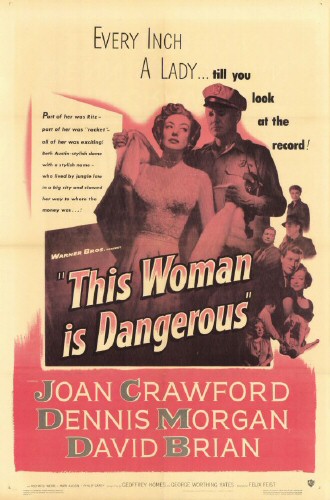

Above: US three-sheet (41 x 81 inches), one-sheet (27 x 41 inches), and window card (14 x 22 inches).
Below: US half-sheet (22 x 28 inches)
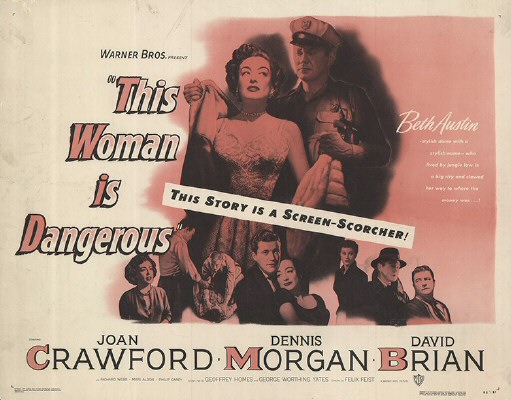
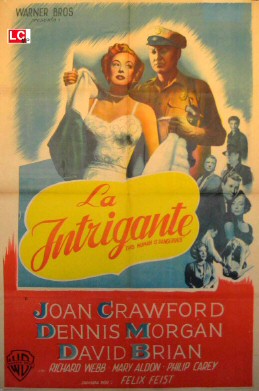


Above: Posters from Argentina, Belgium, and Italy (27 x 40 inches).

Above: US lobby cards.
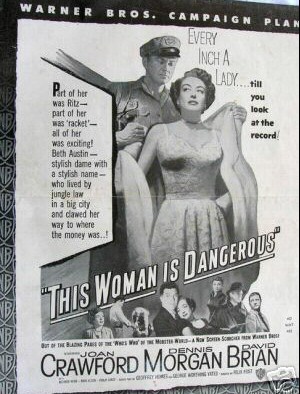
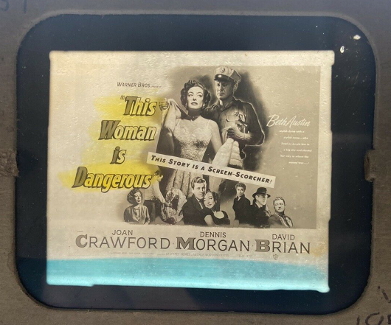
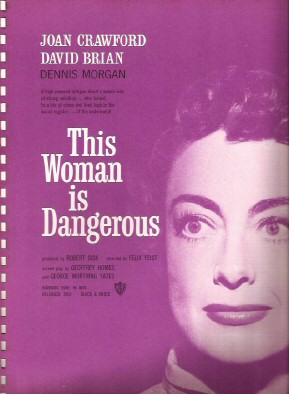
Above: 1952 US pressbook cover, 1952 US theater slide, and 1960s US promo sent to TV studios.
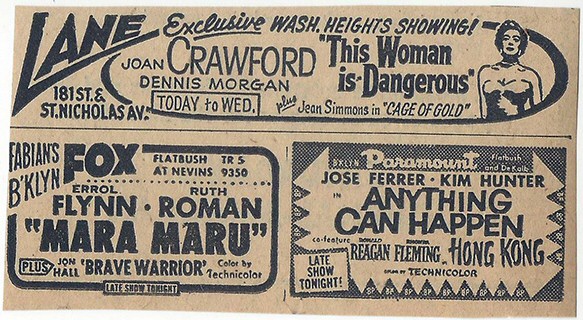
Above: NYC newspaper ad for showing in Washington Heights.
Below: Newspaper ads from Fort Smith, Arkansas.


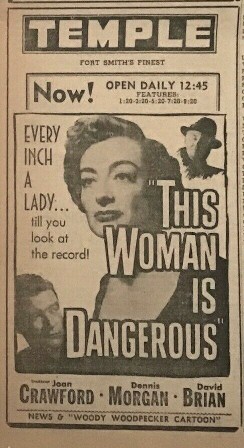
Below: Paramount Theatre marquee in Times Square.
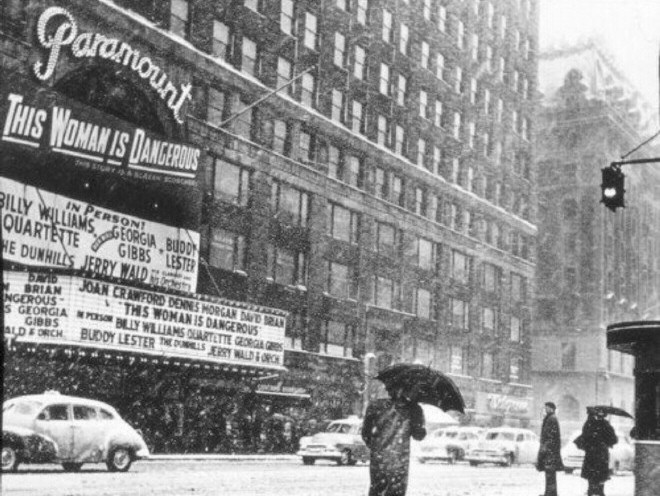
The Best of Everything
